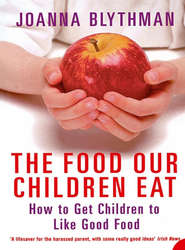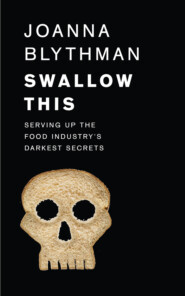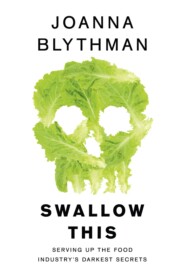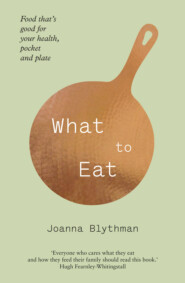По всем вопросам обращайтесь на: info@litportal.ru
(©) 2003-2024.
✖
Bad Food Britain: How A Nation Ruined Its Appetite
Настройки чтения
Размер шрифта
Высота строк
Поля
‘Really, stuff like this does get tiresome. We all know about the excellence and seasonality of Italian food, but every time I go to Italy, the supermarkets there are full of the same old rubbish that they sell here, but we’re always led to believe that every grotty little shepherd is dining like a king on heavenly risottos and garlic-infused baby lambs, while ignorant John Bull has to make do with boiled hoof and carrots because he knows no better.’
In contrast to such defensiveness, our king in waiting, His Royal Highness, Charles, Prince of Wales, (#litres_trial_promo) has accepted that Britain does have a serious problem with what it eats:
‘Over the last two generations we have managed to create a nation of fast food junkies to whom food, often processed by industrialised farming systems, is nothing but fuel. The result is a growing obesity and health problem and a disconnection in the minds of too many people between the food on their plate and where and how it is produced.’
Whether or not we choose to face up to it, Britain has always had a particular credibility problem in convincing the rest of the world of its culinary credentials, and that perception has not substantially shifted. Viewed from outside its borders, Britain is a strange and aberrant country, a cultural exception in Europe, and second only to the US in its capacity to shock outsiders with its eating habits. As one Chinese writer, (#litres_trial_promo) looking forward to his first trip to London, told the Guardian: ‘I’ve tasted an English breakfast but otherwise I’ve heard the food is awful.’ (#litres_trial_promo)
So common are the negative perceptions of British food abroad that bodies charged with attracting visitors to the UK are well-rehearsed in fielding them. The British Council in Japan, for instance, has a website aimed at students who are considering studying in Britain. The site has a Frequently Asked Questions section: Question number 3 (following questions about the cost of study and the weather) deals with what is clearly one of the biggest disincentives to people contemplating visiting, studying or working in the UK:
Q: ‘I’ve heard that British food is boring. Will I be able to find the sort of food that I like?’
A: ‘Britain used to have a bad reputation as far as food is concerned. This has changed dramatically. Britain is a land of lovers of good food. As well as traditional British food which is currently seeing a revival after years of neglect, Indian, French, Greek, Chinese, Italian, Malaysian, Turkish, Mexican and many other ethnic restaurants can be widely found. Japanese food has become popular in Britain during the last few years. There are even kaiten-zushi bars in London!’
While more optimistic potential students might feel reassured, the more cynical might interpret the sub-text as follows: ‘Take it on trust from us that the ghastly things you have heard about British food no longer apply, but just in case you don’t believe us, let us reassure you that there are lots of other cuisines to go for. And if you don’t fancy those, there’s always sushi – in London at least.’
Foreign students contemplating taking a course at the University of Oxford are likewise pre-warned (#litres_trial_promo) as to what to expect:
‘British food does not have a good reputation overseas. However, there is in fact a very wide variety available, both traditional British food and international cuisine, especially in bigger cities. There are many fresh ingredients which are delicious when cooked well. However, many busy people don’t pay much attention to preparing food well and prefer instant meals.’
Of course, it is only natural for foreign nationals to be attached to their own cuisine, to cling on to what they know and even be somewhat suspicious of the food they might encounter when they travel abroad. But the fact remains that British food continues to be notorious worldwide. When Malaysia Tatler (#litres_trial_promo) magazine sent a reviewer to sample the British food at the Ivy restaurant in Kuala Lumpur (no relation to the eponymous London establishment) in 2005, she enjoyed chicken with Stilton and leek, but queried whether it could really be a British dish, as she was ‘surprised that something as tasty could come from there [Britain]’. As Malaysia Tatler pointed out: ‘The British have given many things to the world – television, the steam train, even the internet … But nowhere, on any listing of the island’s achievements will you find the phrase “culinary finesse”.’
In 2003, the results of a survey of Polish attitudes (#litres_trial_promo) towards British food were almost universally negative –108 out of 111 responses. A great many critical comments were recorded, including: ‘tasteless’, ‘unhealthy’, ‘lot of fat’, ‘not many vegetables’, ‘cheap’, ‘industrial’, ‘no specific cuisine’, ‘no traditional food’, ‘not nutritious’ and ‘no good bread’. Indeed, there was repeated amazement at the state of British bread. ‘They [the British] don’t eat normal bread, only tosty’ [white sliced bread],’ one respondent expanded. The existence of vinegar-flavoured crisps raised eyebrows too. Many people commented on the proliferation of fast food and the lack of home cooking in the UK. The problem, concluded one respondent, was that ‘the British don’t really know what good food tastes like’. Another opined that ‘if British people can survive their cooking they can survive anything’.
Speak to people of diverse foreign origins (#litres_trial_promo) who live or work in the UK, and it will quickly become evident that food is one of their biggest obsessions. Wherever they come from, they pick out habits and customs that strike them as incomprehensible and strange, even though they are considered unremarkable by many natives. Most preface their opinions diplomatically with the things they really like about Britain – more personal freedom to live your life as you want being the compliment that crops up most frequently. But when it comes to food, the floodgates open. One German student told me:
‘When I moved to London from Berlin, my first experience of British food was on the boat from Dunkirk to Ramsgate. We wanted to eat something and waiting in the queue I saw them serving lasagne with chips and peas. I just felt so shocked by that, I left the queue and didn’t eat anything, thinking that I really couldn’t cope with this kind of food. The idea of eating chips with lasagne!’
That hoary old stereotype – chips with everything – still crops up regularly in outsiders’ images of British food. The traditional fish supper, (#litres_trial_promo) in particular, described by Egon Ronay as Britain’s ‘most distinctive contribution to world cuisine’, finds few admirers; on the contrary, most people from abroad are bemused by Britain’s fondness for what they see as an unappetizingly greasy meal, served without knives and forks and eaten from dirty newspaper. Others cannot get over Britain’s addiction to food consumed on the hoof. ‘When I first arrived I was surprised to see how people walk about eating in the street and quite astonished to see school children walking around at lunchtime eating a packet of crisps and some sweets,’ a French Cameroonian engineer told me. ‘The French have a completely different attitude. Either you go home for lunch or stay and eat in the canteen.’ People from other countries are gobsmacked by the food that British children eat. A Dutch mother told me:
‘Until I came to Britain, my children had never been exposed to sweets at all. My kids didn’t even think about them. They liked fruit but it was impossible to keep that up because always when they entered the nursery or playgroup in Britain there were people giving them sweets; not just biscuits – things like sticky sweets and fizzy drinks. In kindergarten in Holland, the kids got fruit and yogurt, but no sweets. It would be unheard of in Holland if the kids brought in crisps and sweets from home. They would not be allowed, a bit like bringing cigarettes into school. Here the kids open a lunch pack and there is at least one packet of crisps, one Mars bar or similar, and then they have these really weird takes on real food like cheese strings or something where they make the food into a funny, dinosaur shape. In order to persuade a child to eat a piece of cheese in Britain they have to make it into a shape!’
A Danish artist told me that when she arrived in the UK, she could not get over the contents of British shopping trolleys:
‘When standing in line I noticed what people had in their shopping baskets, all that sugar and fat in there, and I would be really amazed to see even old people stocking up with junk. Three years later I stand at the checkout here and still can’t get over all those trolleys filled with big amounts of pies, ready-made food, and lots of crisps – but without any vegetables. A Danish trolley, irrespective of social class, would look much different. In a word, “greener”. We eat a lot more green food and our dishes look nicer as a result because we eat more salads, more stewed vegetables, more vegetables on the side as a garnish.’
An Italian teacher recounted her first encounter with prospective in-laws, picking out what she saw as the entirely alien habit of staggered eating, the unceremonious speed of eating, and the lack of effort that goes into food in the UK.
‘I went to my [British] husband’s family for Christmas. It was a huge cultural shock, the saddest Christmas in my life. If somebody had come to my house in Emilia Romagna at any time, not even a festive period, my mum would make an extra effort – a special pasta, a special secondo [meat or fish course], more of everything, a real welcome. But I don’t think his mum is cooking at all. She doesn’t care about that. When it was lunchtime she said “Everything is in the fridge, everybody can help themselves” and off she went. At about 12 o’clock, his dad would go to fridge and make himself a sandwich, at 12.30 his sister served herself and so on. The day after was the same. At the actual Christmas dinner, after half an hour, all the food had already disappeared from the table. I have had to adapt to it, but for me, it was definitely shocking.’
People from abroad are regularly baffled by what they see as a lack of family meals and communal eating. One Austrian arts administrator explained:
‘Now that I live in Britain I still cook every night. We eat together every night and that is a most important time for us. But I see from other British families that this is considered really strange. In the UK, eating together is almost something you do on a Sunday if you are a “good” family. It’s really important to me that we sit properly, half an hour or so – not like in France where they take one and a half hours – and not a fancy meal necessarily, just something that’s properly cooked. We would not sit at the TV and eat either. I notice people do that here. You don’t come across much of what I would call proper, normal eating in the UK.’
For an executive summary of the outsider’s verdict on British food and eating habits, click onto the web pages of ‘Grenouilles au Royaume Uni’ (#litres_trial_promo) (‘Frogs in the UK’), a reportage by French people living in Britain, and look under the ironic heading ‘The Delights of British Cuisine’:
‘The British no longer consider a meal as a family ritual. That’s a growing trend in France too but it’s more noticeable here. English families cook less in general and rely more on food delivered to their homes. Members of the same family tend to eat on their own when they feel hungry. Hence the profusion of junk food, fast food, takeaway and so on. Direct consequence: 39 per cent of Britons are overweight, 19 per cent are obese.’
Although most Britons view it as entirely normal, Terry Durack, (#litres_trial_promo) restaurant critic for the Independent on Sunday, has voiced the ongoing incomprehension with which British eating habits are viewed internationally:
‘As an Australian, I often find myself blinking in disbelief at the average Briton’s relationship with food, at how unimportant it is to so many people. But then, I grew up in a country where good food was available to all at a good price. Here [in Britain], eating well is an economic issue, a class issue, and an education issue. Good food is available – at a price. And nobody is going to pay the price if good food is simply not a priority in their lives.’
Whether we like to admit it, Britain is seen abroad as a country that has well and truly lost the gastronomic plot, a food recidivist, demonstrating precious little capacity for improvement.
3 BRIT FOOD (#ulink_cac3da2a-52e2-5cf0-8bec-277a136c06b1)
Any country with a healthy food culture has a distinct body of ingredients and dishes that that can be recognized widely as constituting a national cuisine, but in Britain even the native population has some difficulty agreeing on such a definition. Expatriate Britons, on the other hand, seem entirely clear. Scan the catalogues of companies that purvey distinctive British foods to Britons in the diaspora, such as Best of British (#litres_trial_promo) – a chain of stores throughout France – and you will be left in no doubt about what they crave. Their mission statement reads:
‘It is good, from time to time, to be able to have some of those traditional British foods we so enjoyed in the UK; a good fry-up with bacon, pork sausages and beans, steak and kidney pies, battered cod with mushy peas, proper curry, syrup sponge with real custard, trifle, etc. You will find them all at Best of British.’
To French people who happen on Best of British, the stock must appear bizarre. For the most part, the goods on offer represent a drab, sad testament to Britain’s addiction to over-processed, industrial food: Plumrose pork luncheon meat, Jackson’s white sliced bread, Tunnock’s marshmallow snowballs, Cadbury’s Curly Wurlys, Bisto gravy granules, Walker’s prawn cocktail crisps, Angel Delight, Spam, Pot Noodles, Heinz tinned coleslaw, spaghetti hoops and salad cream, Princes Hot Dogs, Campbell’s condensed mushroom soup, Hula Hoops, Fray Bentos tinned steak and kidney, frozen sausage rolls and Birds Dream Topping are just a few of the treats in store. For some Britons based abroad, these are delights to seek out and savour.
Wherever they go in the world, Britons like to uphold their food traditions and remain loyal to an unedifying portfolio of industrial products whose main selling point is that they make cooking more or less redundant. An internet search for ‘British food’ will find a bevy of other companies – Brit Essentials, UK Goods, The British Shoppe, British Delights, Brit Superstore, British Corner Shop, amongst others – with a flourishing trade in much-loved, quintessential British foods. Branston pickle, Daddy’s Sauce, Bovril, Twiglets, Ribena, Bird’s custard powder, Oxo cubes, instant coffee, Heinz tomato soup, Ambrosia creamed rice, Coleman’s Cook-In sauces, tinned meat paste, Paxo sage and onion stuffing, fruit-free fruit-flavour jellies, Burton’s Wagon Wheels, ‘fun-size’ confectionery, and Yorkshire pudding mix are all typical offerings.
Far from being food best left back in Blighty, these products are very much in demand, as one company that sends them to customers’ doorsteps (#litres_trial_promo) all around the world explains: ‘As ex-expats ourselves, we fully understand your frustrations in obtaining a taste of Britain in your new country. It seemed like Christmas when we did find a shop selling British (#litres_trial_promo) products.’ Frequently, these much-missed British foods are on show at social events run by Britons living abroad. Bemused local guests might be invited to British ‘curry suppers’ (#litres_trial_promo) or parties where a common offering is the nominally Mexican chilli con carne, made in the British style using mince and served with rice, to be eaten from a bowl while standing up – followed by mini Mars bars.
Back in the UK, those intent on promoting the idea that Britain has lately undergone a food revolution and developed a food culture that can hold its head up, not only in Europe but in the world at large, would hasten to point out that many of these products are reminiscent of the stock list of a 1960s convenience store, and not at all representative of the way most British people now like to eat. If this is the case, then what exactly is ‘British food’ nowadays?
In reality, this is a bit of a puzzle, both to the British and to other nationalities. Up until the 1970s, we had something that amounted to a national cuisine, a repertoire of commonly eaten dishes which most citizens would agree were British; toad-in-the-hole, roast meat with roast potatoes, Lancashire hotpot, boiled beef and carrots, mince and potatoes, bangers and mash, tripe with onions, boiled ham with parsley sauce, broths and hearty soups, shepherd’s pie, oxtail stew, cauliflower cheese, potted shrimp, steak pie, kippers, raised pies, steak and kidney pudding, jellied eel and any number of stick-to-the-ribs puddings. Depending on who you listen to, this cuisine was either a) monotonous and almost invariably badly cooked or b) straightforward, appetizing and wholesome. Either way, at least it was based on native raw ingredients – give or take a few billion packets of gravy powder.
Even then, a certain confusion reigned. In countries with consolidated eating traditions, ‘national’ is the sum of the ‘local’ parts. In Britain, on the other hand, what was once ‘local’ – Cumberland sausage, York ham, Melton Mowbray pie – becomes a ‘national’ dish, which may be a reflection of the absence of regional food pride, or perhaps a sign of desperation about the thinness of Britain’s food culture.
In 1998, the food writer Sybil Kapoor made a valiant attempt to map out a newer, more relevant definition for British food in her evocative book Simply British. (#litres_trial_promo) She abandoned any attempt at classification based on a body of popular dishes or culinary techniques, in favour of a collection of intrinsically British ingredients. ‘In my opinion,’ she wrote, ‘there is only one thing that unifies and defines British cooking and that is its ingredients.’ But while the book was an appetizing and much-needed reminder to the British that good cooking starts with fresh, indigenous materials, any territorial claim to ingredients is bound to be subject to counter-claim. For all we may try to assert the gastronomic equivalent of intellectual property rights over ingredients such as lamb, beetroot, lavender and greens, neither the Greeks, the Russians, the French nor the Chinese, respectively, will accept it.
In 2004, the author and chef William Black set out on a tour around Britain to seek out the country’s traditional specialities for his book The Land That Thyme Forgot. (#litres_trial_promo) He wanted to taste ‘enigmatic, mysterious dishes’ like Hindle Wakes (boiled fowl stuffed with prunes served with a rich lemony butter sauce and herbs), Clanger (a suet crust pastry with meat in one end and jam in the other) and Salamangundie (a sort of salad made with eggs, anchovies, onion, chicken and grapes). At the beginning of his journey, Mr Blake was ‘absolutely convinced that somewhere there was a vibrant regionalism just waiting to blossom’, but he never did get to taste most of the dishes he wanted to because they had simply dropped off Britain’s culinary map. In the spirit of an archaeologist hastily excavating a site before the developers move in, he catalogued a list of British specialities or GODs (Great Obscure Dishes), appealing to readers to adopt a dish as a contribution towards nursing British food back to culinary health. Into this sanatorium he put regional specialities that one might have expected to be in a more healthy state, such as Yorkshire Fat Rascals (a fruit scone/rock cake hybrid), Syllabub (wine sweetened with whipped cream) and Liverpool Scouse (meat and potato stew). His conclusions made gloomy reading:
‘As I travelled around the country I did get a sense of a revival in regional food but it seemed a very one-sided, haphazard affair indeed, Yes, farmers’ markets are springing up all over the place, and these arenas at least allow us to talk to producers and begin to amass a degree of awareness about food, nutrition and seasonality, but at a price. Much of the produce seems so insanely expensive to most of us when compared to the mass-produced pap we are accustomed to buying in the local supermarket that we often find it hard to get it into perspective. In other words, any good food movement is perceived as elitist … Is it too late for us ever to revive this disappearing gastronomy? Quite possibly. But we can nag. And rootle around and search for this golden grail, a renascent food culture that has to be more than just the ability to buy carrots with mud on them, and the odd farmhouse cheese.’
Slowly but surely, over the last 20 years, as our food shopping tastes have been shaped and increasingly dominated by supermarkets, Britain has abandoned its native gastronomy and become the culinary magpie of the world, raiding other countries’ gastronomic heritages and stockpiling their offerings for its nest. Although we live in a globalized age where true diversity is ever more elusive, most countries, both rich and poor, can still point to dishes that are more or less uniquely their own and perceived by outsiders as such. Germans eat sauerkraut; Vietnamese enjoy pho; Czechs are loyal to goulash and dumplings; Sri Lankans won’t go long without eating a stringhopper. The British? Well, that will be lasagne, moussaka, chicken kiev, pizza, fajitas, baltis, Thai red curry, hummus – basically, anything other than British.
The British actively project this magpie persona abroad. Every two years, different countries proudly showcase their cutting-edge food wares at the Anuga trade show in Germany. In 2005, smiling staff at the ‘Best of British’ section were pictured by The Grocer (#litres_trial_promo) magazine standing proudly in front of displays, not of Lincolnshire chine or Bakewell tarts, but of pot noodles and crisps with ‘authentic British flavours’. What the word ‘authentic’ meant in relation to laboratory flavourings was not made explicit, but it was evidently thought to be a selling point that these crisps offered six months’ shelf-life, and labelling in eleven foreign languages. Britain’s weakness for junk food is now so longstanding, that our taste for it can almost count as traditional. In the same article, The Grocer noted that while other countries focused on traditional products normally associated with them – pasta and olive oil from Italy, cheese from Holland, and so on – ‘the 63-strong Food From Britain section was a real cornucopia of world cuisine with Indian and Oriental brands putting on a strong show’. This is what Britain’s food industry does best these days: snack-bar sushi, instant noodles, frozen pizza, gloopy stir-fry sauce, long-life Peking duck wraps … We are now the international specialists in making inferior industrial copies of other countries’ favourite foods.
No one jumped to contradict the Foreign Secretary Robin Cook in 2001 when he hailed chicken tikka masala (#litres_trial_promo) as the most popular British dish. Chicken tikka masala (#litres_trial_promo) is a British ‘Indian’ dish, unrecognized in India, invented by a Bangladeshi cook. Mr Cook hailed it as ‘a perfect illustration of the way Britain absorbs and adapts external influences’ on the grounds that the masala sauce was devised to ‘satisfy the desire of British people for gravy’. But this dish is really a symbol of the weakness of the indigenous cuisine in Britain, and is a demonstration of the British tendency to fill this vacuum by importing and traducing misunderstood foreign dishes.
At a more nostalgic, emotional level, the British do still want to cling on to a more coherent, traditionally British food identity. However, an attempt to unite our culinary past with our eclectic culinary present is not without difficulties – witness the marketing pitch for chef James Martin’s (#litres_trial_promo) 2005 book, Easy British Food:
‘Typically when asked about British food, thoughts turn immediately to a plate of good old fish and chips followed by the less inspiring meat and two veg. This is just not the case anymore – Britain is jam-packed with a diverse and delicious variety of food … James has packed the book full of classic dishes you thought only your mother had the secret to from homemade Cumberland sausages to Welsh rarebit, from jam roly poly to raspberry Pavlova, Easy British Food does not disappoint.’
That is the British bit of the sell, but everyone from the editor to the sales manager knows that a volume of straight, traditional British cooking is not commercial enough or sufficiently seductive to market to Britons sceptical about their own culinary heritage, so it needs a hint of foreign promise added:
‘Inherited British favourites from overseas have not been overlooked – Margarita pizza, lamb curry, salmon risotto and crème brulée are all now firm favourites in the heart of the British nation, all of these and more are made easy in this delicious collection …’
This voices the almost pathetic British need to make foreign dishes our own in order to compensate for what we consider to be the inadequacies of our own native cooking tradition. This is our new food identity, dipping into cuisines from all over the world and trying to unite them in a new composite product that can plausibly be regarded as British. While Queen Elizabeth II (#litres_trial_promo) may still represent a more conservative British palate – she is said not to like garlic or long pasta – market research has shown that Britain is the country in Europe most fond of foreign tastes. Seven out of ten Britons say that they ‘like foreign food’ (#litres_trial_promo) compared to 29 per cent of Spaniards. One survey of European eating habits (#litres_trial_promo) remarked on how Germans were ‘conservative consumers’ favouring traditional German food. The same applied to Spaniards whose eating habits remain ‘still very much based on a Mediterranean-type diet’. While Britain likes to commend itself, quite legitimately, on its openness to foreign culinary ideas and influences, there is no escaping the fact that this taste is powered by lack of belief in our indigenous gastronomy.
The British lack of culinary confidence was demonstrated rather spectacularly (twice) during US President George Bush’s 2003 visit to the UK. (#litres_trial_promo) At Buckingham Palace, the Queen served him a meal – billed as ‘Le Menu’ – consisting of potage Germiny, délice de flétan aux herbes, suprème de poulet fermier au basilica, and bombe glacée Copelia, which was French both in language and concept. Dining at Downing Street with Tony Blair, eating a menu created by Nigella Lawson, the American President was treated to roast pumpkin, radicchio and Welsh feta salad, braised ham with honey and mustard glaze, creamed potatoes and seasonal vegetables, followed by double-baked apple pie with cheddar crust and vanilla ice cream. The Guardian’sMatthew Fort, (#litres_trial_promo) for one, was unimpressed:
‘You might have thought that the occasion of the state visit of an American president would herald a little tub-thumping of our own, for the culinary fireworks which we have been so busy claiming for ourselves … It sounds quite tasty and homely … but I can’t help feeling that Queen Nigella may have gone a bit far in the hand of friendship direction in an effort to make Citizen Bush feel at home. Pumpkin has a greater following in America than it does here … and what is more American than apple pie, with or without the cheddar crust? … Come to that, when has radicchio been a British vegetable of choice? And why feta cheese, Welsh or not? What’s wrong with Caerphilly?’
When ambassadors for Britain are so half-hearted about serving British food, it is no surprise that ordinary people feel the same way. By 2004, only 63 per cent of the food eaten in Britain was home-produced, (#litres_trial_promo) down from 75 per cent in 1994. We seem to be eating less native produce, not more. This situation is in part a reflection of the preference of British supermarkets for global sourcing which leads to diminishing amounts of British food on British shelves. In 2005, a survey by Friends of the Earth (#litres_trial_promo) found that two-thirds of the apples sold in the height of the UK apple season came from overseas. Some of the apple varieties being offered had travelled more than 12,000 miles. The reliance of supermarkets on cheap imported foods means that Britons who do want to buy British food find it difficult to do so.










